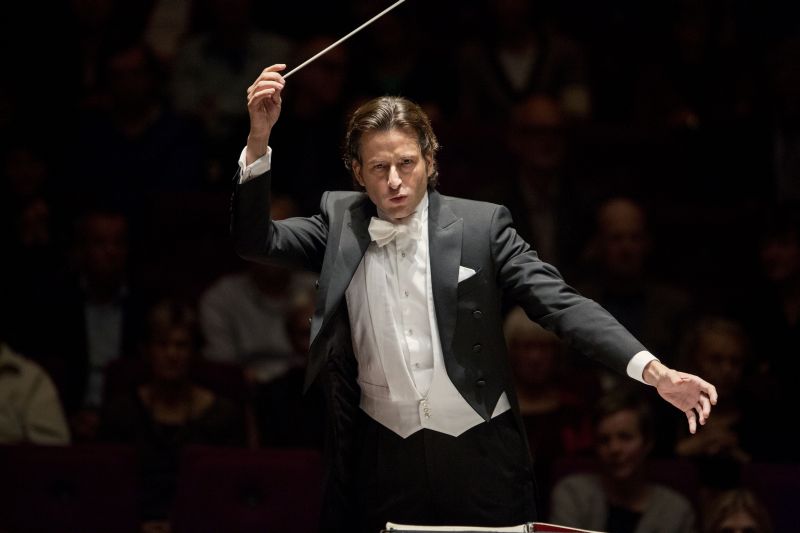Unwieldy program apart, Toronto Symphony Orchestra makes an admirable Carnegie stand

An orchestra going on tour offers a chance to put its best foot forward in two ways: demonstrate its musical skill and polish through pieces that get extra attention in preparation; and display thinking and taste that sets it apart from its peers.
The Toronto Symphony Orchestra’s current tour brought it to Carnegie Hall Monday night, conducted by music director Gustavo Gimeno and with violinist Maria Dueñas as a guest artist. Their playing showed that this is indeed a fine ensemble, though it didn’t completely overcome some odd programming choices. The orchestra played the American premiere of Samy Moussa’s Symphony No. 2, then followed with Dueñas soloing in Lalo’s Symphonie espagnole. After intermission, the orchestra played Gimeno’s own compilation of a suite of music from Prokofiev’s Romeo and Juliet.
The idea seemed to be to show how expressive the orchestra could be through both older and modern romantic sensibilities. While not intrinsically a problem, the challenge was that within the great variety of that aesthetic, the choices emphasized a darkness that proved monotonous at times—compounded by the concert’s sheer length. Nor did the exception consistently display the orchestra at its best.
Moussa’s symphony opened the one-hour-plus first half. The strength of this work is the quirky orchestration, which eschewed trombones and put flugelhorns to the fore. This, along with the slow brass fanfare that opened the piece, gave it an intriguing Wagnerian color. It also highlighted what is clearly a terrific brass section.
From there, the piece glided through connected, but clearly defined, sections, full of dark lyricism and in one stretch a scherzo-like sensibility. This symphony in one movement had a strong feeling of companionship with Samuel Barber’s Symphony No. 1, including a reprise of the opening fanfare material and an explosive tension-release structure. The orchestra’s energy and volume were impressive, but the work ultimately felt hollow inside. As skillful as the details were, it seemed to lack a key harmonic richness that would have convincingly connected aims with means.
Lalo’s Symphonie espagnole brought out much brighter colors and more transparent detail in the orchestra, but the spotlight was on Maria Dueñas. The young violinist was fleet and agile, tossing off the flurry of notes and phrases with excellent articulation. She has an old-school manner of almost-continuous vibrato, which at times seemed odd and excessive. There were occasionally glimpses of an attractive, gentle grain to her sound when she held a note for a moment without vibrato, but these were too few.
Behind her, the orchestra sounded subdued and in more of a supporting role. The sonic disconnect between it and Dueñas was exacerbated by her tendency to rush through faster passages. Neither soloist nor ensemble were fully convincing in the Spanish rhythms, which needed either a touch more bite or more delicacy. Still, the Andante was lovely, and Dueñas’ playing was often captivating, and the final Rondo was a pleasure. Dueñas’s more subdued encore was an arrangement of Francisco Tárrega’s guitar piece, Recuerdos de la Alhambra.
The playing in Prokofiev’s Romeo and Juliet was often deeply stirring, and the orchestra’s playing just as frequently brilliant. Gimeno’s selections came to about 45 minutes of music—substantial but not in itself excessive but he put disproportionate weight on the back end via the complete music for Romeo at Juliet’s tomb and Juliet’s death, and the weight of this contributed to a cumulative heavy darkness on the performance and the overall concert.
Prior to the final sections, the playing was at the highest level, full of energy and detailed skill. While the Montagues and Capulets music was just short of the force it demands, the rest of the playing was excellent. The strings were both full and dexterous, the woodwinds had beautiful colors and projected strongly. There were plenty of thrills and charms in the music for the young Juliet and the Balcony Scene, and Prokofiev’s sardonic, yet sincere, energy was a welcome addition to the tone of the concert.
Audience attention began to audibly flag in the last sections, even with Gimeno and the musicians clearly trying to hold onto the final note. Still, there were enough fans to keep it all going, calling the orchestra out for two encores, a subdued Lyrical Waltz from Shostakovich’s Ballet Suite No. 1, then “Somewhere” from West Side Story, which, surprisingly, in the end hit the right tone.
The Czech National Symphony Orchestra plays Dvořák, Brahms, and Beethoven, 8 p.m. Thursday. carnegiehall.org






